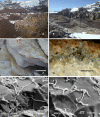Drought meets acid: three new genera in a dothidealean clade of extremotolerant fungi
- PMID: 19287523
- PMCID: PMC2610311
- DOI: 10.3114/sim.2008.61.01
Drought meets acid: three new genera in a dothidealean clade of extremotolerant fungi
Abstract
Fungal strains isolated from rocks and lichens collected in the Antarctic ice-free area of the Victoria Land, one of the coldest and driest habitats on earth, were found in two phylogenetically isolated positions within the subclass Dothideomycetidae. They are here reported as new genera and species, Recurvomyces mirabilisgen. nov., sp. nov. and Elasticomyces elasticusgen. nov., sp. nov. The nearest neighbours within the clades were other rock-inhabiting fungi from dry environments, either cold or hot. Plant-associated Mycosphaerella-like species, known as invaders of leathery leaves in semi-arid climates, are also phylogenetically related with the new taxa. The clusters are also related to the halophilic species Hortaea werneckii, as well as to acidophilic fungi. One of the latter, able to grow at pH 0, is Scytalidium acidophilum, which is ascribed here to the newly validated genus Acidomyces. The ecological implications of this finding are discussed.
Keywords: Acidophilic fungi; Antarctica; ITS; SSU; black fungi; extremotolerance; halophilic fungi; lichens; phylogeny; rock-inhabiting fungi; taxonomy.
Figures








References
-
- Bills GF, Collado J, Ruibal C, Peláez F, Platas G (2004). Hormonema carpetanum sp. nov., a new lineage of dothideaceous black yeasts from Spain. Studies in Mycology 50: 149–157.
-
- Bogomolova EV, Minter DW (2003). A new microcolonial rock-inhabiting fungus from marble in Chersonesos (Crimea, Ukraine). Mycotaxon 86: 195–204.
-
- Bruns TD, Vilgalys R, Barns SM, Gonzalez D, Hibbett DS, Lane DJ, Simon L, Stickel S, Szaro TM, Weisburg WG (1992). Evolutionary relationships within the fungi: analyses of nuclear small subunit rRNA sequences. Molecular Phylogenetics and Evolution 1: 231–241. - PubMed
-
- Butin H, Pehl L, Hoog GS de, Wollenzien U (1996). Trimmatostroma abietis sp. nov. (Hyphomycetes) and related species. Antonie van Leeuwenhoek 69: 203–209. - PubMed
LinkOut - more resources
Full Text Sources
Molecular Biology Databases
